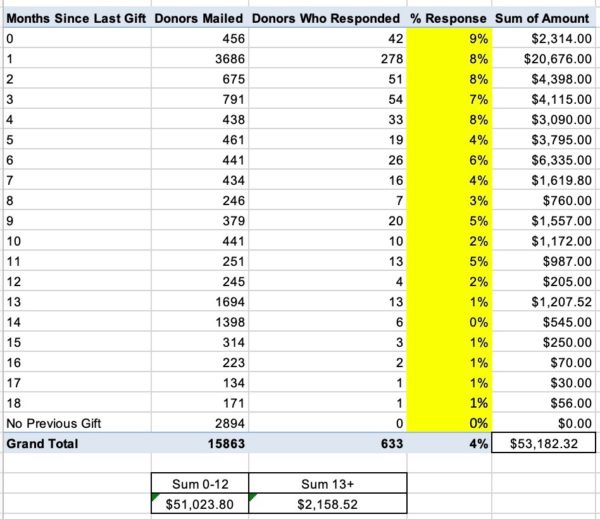The spreadsheet below illustrates a powerful truth:
The more recently a donor has given to your organization, the more likely they are to give to you again.
So for heaven’s sake don’t “rest” your donors and miss out on your best chance for them to give you another gift – and all the revenue that comes with it.
Short Story, Then Data
Let me tell you what you’re looking at.
A nonprofit was working on their January appeal. We recommended that the appeal be sent to all donors who had given a gift in the last 18 months.
They said, “But we can’t include the people who gave at the end of the year. They’ll be annoyed to be asked again so soon.”
We told them that the people who gave recently are exactly who they want to mail to. We said that recent donors were more likely to respond to the January appeal than other donors.
They didn’t really believe us.
But they agreed to proceed because everything we’d been doing with them was working like crazy. And we promised to analyze the response to the appeal to see if what we’d been teaching them about recency was true. *
Data, Sorted by Number of Months Since Previous Gift
Here’s the data. Pay particular attention to the column in yellow. It shows you the response rate sorted by the number of months since the donor’s previous gift. The farther down the column you go, the more months it had been since the donor had given a gift.

Look at the top line! The people who had given a gift in the last 30 days were the people who responded best to the appeal!
The group of people who had given a gift in the last 2 months gave a little less than half the total income from this appeal.
As you go down the yellow “% Response” column you see that the more recently a donor had given a gift to this organization, the more likely they were to give again.
What Does This Tell You?
Do not “rest” your donors by pulling them out of appeals for several weeks or months.
Do not “take your donors out and not ask them again until next year.” (Last Friday on Free Review Fridays there was an organization that was doing that.)
By waiting to ask your donors again you’re reducing the chance they will give to you again, not increasing the chance. In other words, you’re raising less money, not more. **
The $$$$ Consequences of ‘Resting’
Let’s look at a couple scenarios for the big group of donors who had given a gift 1 month prior. There were 3,686 of them who received the appeal. 9% of them gave a gift, and they gave a total of $20,676.
First scenario. What would have happened if this organization had “rested” their donors for a couple of months? Those 3,686 donors would not have received this appeal. The organization would have lost out on $20,676 in gross revenue.
Twenty. Thousand. Bucks. Just. Poof. Because the organization was fearful of the mostly mythical “donor fatigue.” That’s a concrete example of how fears around “asking too much” cause organizations to raise significantly less money.
Second scenario. What would have happened if they’d “rested” those donors for 6 months? According to the data, we can estimate that only 5% of them would have responded instead of 9%. So the organization would have raised $11,481 from that group instead of $20,676 (presuming average gift size is the same).
They would have raised $9,195 less by “resting” their donors for 6 months.
Think about that the next time someone in your organization wants to rest your donors.
And the crazy part is that it gets even worse! In addition to raising $9,195 less from that group of donors, by holding that group out of appeals and newsletters for 6 months the organization would completely miss out on all the other gifts that group would have given over those months.
Don’t Worry About “Donor Fatigue”
I can already hear the question.
“But what about donor fatigue?”
I have never seen “donor fatigue” in an organization that sends out fewer than 18 pieces of direct mail a year (plus emails). ***
As you mail and email your donors more often, you’ll hear complaints, sure. And the Board won’t like it. And a small percentage of major donors will ask to be taken out of your mass donor communications.
But in exchange for those “costs” you’ll raise more money, have higher donor retention rates, and do more good.
The organization that sent the appeal letter above used to send 8 appeals and 2 newsletters a year. With our help they currently send 13 appeals a year and 4 newsletters. Plus emails.
They raise a lot more money than they used to.
And their donor retention increased. They used to retain about 55 out of 100 donors every year. Now they retain about 63 out of 100 donors every year.
In other words, they communicated more with their donors and FAR more good things happened than bad things. Put more precisely, they gladly accepted a few complaints and treated a few major donors differently in exchange for more revenue, donors, and impact.
Of course you have to send out good fundraising. Donor-focused appeals with good offers. Newsletters that give donors the credit. Etcetera.
More is More
Don’t “rest” your donors.
Send out more appeals, e-appeals and newsletters.
The way to get better at those appeals, e-appeals and newsletters is to practice.
You’ll be better at it a year from now. But only if you start practicing today.
Seek and accept expertise, but don’t let that delay you from starting.
As soon as you can.
And include your most recent donors!
* Of course there are cases where recency should not be the primary segmentation variable. If you’re already using a segmentation model more sophisticated than RFM, thank your lucky stars you’ve had the chance to learn such things, and know that this post is not for you.
** This applies to major donors, too, though not quite as linearly. The maxim holds, but you may know things about individual donors that exempts those particular donors. For instance, perhaps they have a family foundation that gives gifts once a year. Or they’ve told you that they’re only going to give one gift this year. The path to increased revenue from major donors, in our experience, is to be comfortable asking them for gifts more than once a year (within a system of Asking, Thanking and Reporting). The mistake is to take one major donor’s preference and use it as a strategy for all major donors.
*** The key here is to measure the right things. You want to measure and prioritize donor retention levels by segment, and Net Revenue. You want to pay the appropriate amount of attention to complaints, unsubscribes, and contacts from Majors. Pay attention to the performance of the group, not the squeaky wheels. Segmentation is your friend.

